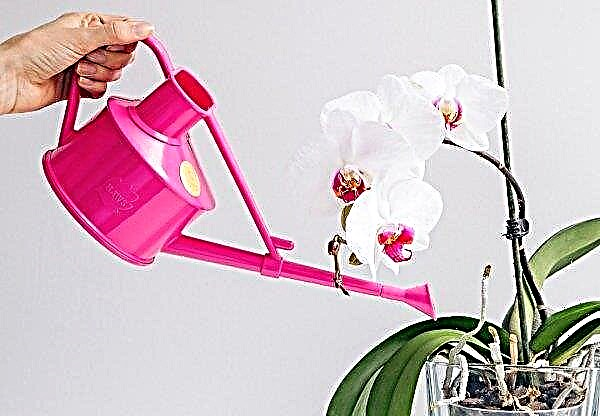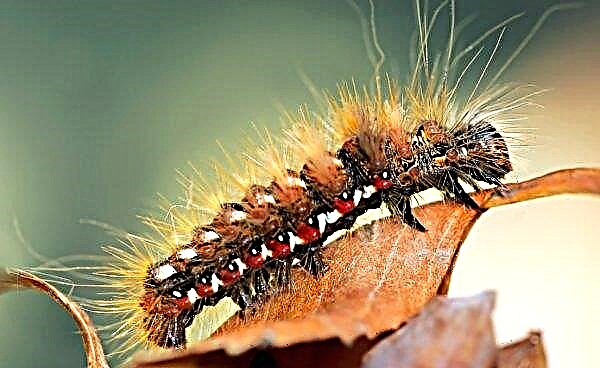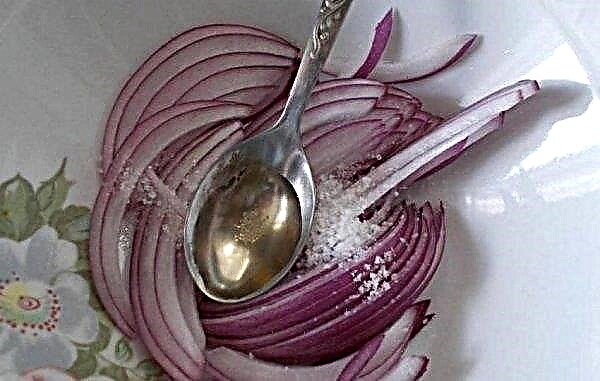From this article you will learn what kind of Japanese (Chinese) gladiolus crocosmia should be selected for your site and how to properly care for it. These flowers are quite unpretentious and, at the same time, attract attention. They will be a wonderful decoration and complement your garden composition.
Plant description
The plant is called crocosmia (lat. Crocosmia) or montbrecia. Like gladiolus (fennel), it also belongs to the Iris family, but to a different genus. This flower is often used in landscaping, because it is unpretentious in care, has a long flowering period and attractive appearance. During flowering, small, delicate and beautiful star-shaped flowers adorn it. Their diameter is 5 cm. Crocosmia panicles are similar in appearance to iris. The plant blooms from July to September - October.
Did you know? In the era of antiquity, the sharp leaves of the gladiolus caused associations with weapons, so its tubers were considered amulets that could protect the warrior from death.
The flower smells nice, not intrusive, remotely resembling saffron. The corms of the plant are small, covered with three layers of a protective peel. From one bulb, three peduncles are obtained. The root system consists of two tiers. The first is the roots of the mother's bulb, and the second grows between the planting and replacing. The leaves grow to a length of 60 cm, having a xiphoid shape. The stem is branched and thin; growing, reaches 1.5 m.
What are the varieties
The most popular varieties of crocosmia are as follows:
- Lucifer. It tolerates cold, up to -30 ° C. Reaches a height of up to 1.5 m. Inflorescences are bright red in color.
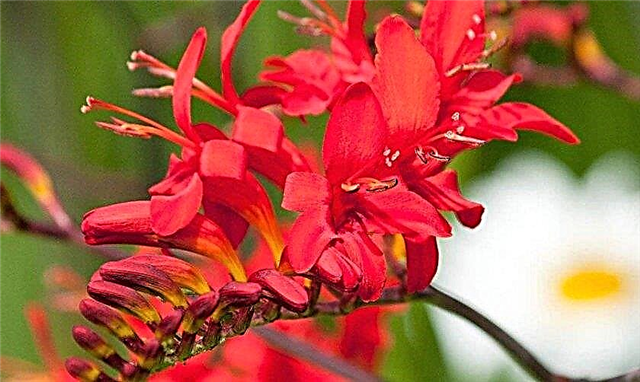
- Mainos. Frost resistant. Inflorescences are saturated red.

- Emily Mackenzie. It tolerates temperature extremes. Inflorescences are spike-shaped. The color is orange, saturated. In height reaches 60 cm.
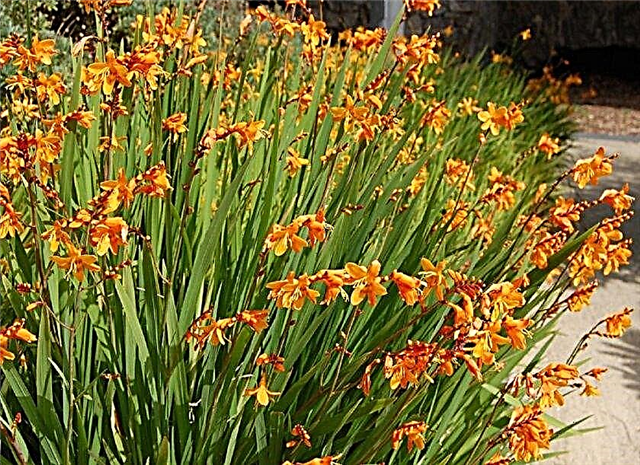
- His Majesty. Tolerates frosts. Winters better indoors.
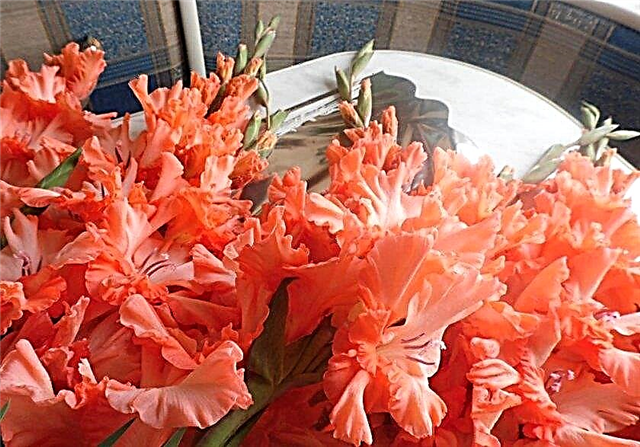
- Potsa. Has small pink inflorescences. It grows to 1 m.
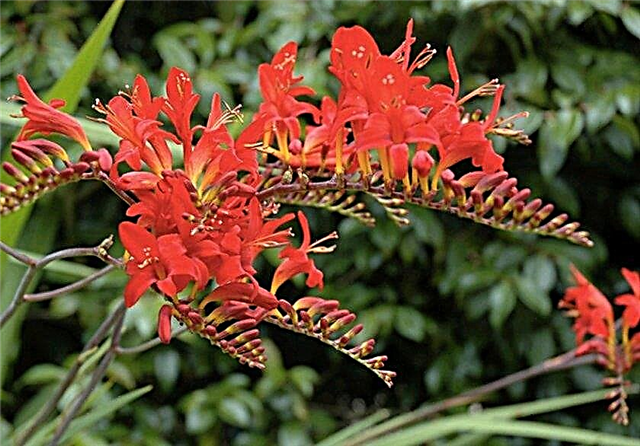
- George Davison. It adapts well to new climatic conditions. The flowers grow amber. In height, the stems grow no higher than 80 cm.
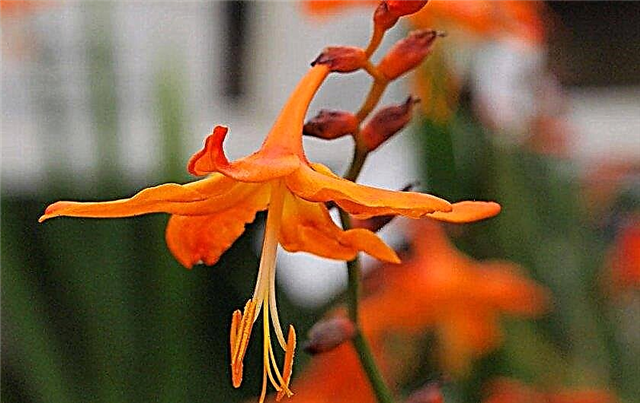
- Masoniorum. The grade is tall. Reaches 1,5 m. Color orange.
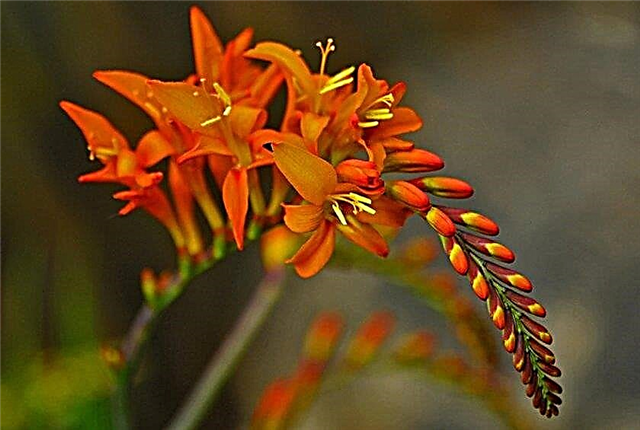
- Babylon. Undersized. A maximum of 50 cm grows in height. It has an orange color.

- Paniculate. Tall, frost-resistant. Inflorescences of orange shades.
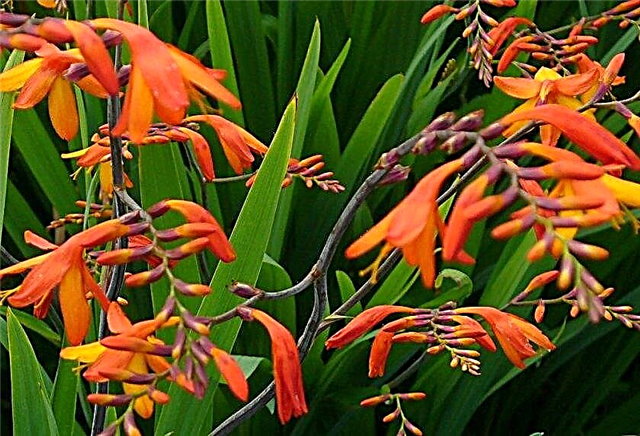
- Star of the East. It has large flowers of orange hues. It tolerates frosts poorly.

No less popular among landscape designers is the Canary Islands variety. Flowers of a yellow plant. It has a decorative shape and reaches a maximum height of 60 cm.
Landing and Care
The refined plant is among the favorites of beginner gardeners and landscape art professionals, not only because of its unique appearance. This bulbous culture is unpretentious and caring for it will not cause you much trouble. The main thing is to choose a quality planting material and determine a site that is suitable for the composition of the soil. And then montbrecia will delight you with a long, from early summer to late autumn, flowering and lush armfuls of densely collected unusual leaves.
When buying large, which means enough adult bulbs, you can appreciate the beauty of the flower in the first year. In general, the landing unit is productive for no more than 4 years and a diameter too large, more than 4-5 cm, indicates the age and unsuitability of the material. The main sign of health is a clean, tidy bottom and the absence of any mechanical damage to the surface. As a rule, two sprouts are pecked at such immediately and, having peeled the husk, you can see a deep dividing line. It is along this groove that the corms can be easily divided in two with little effort. It is not recommended to purchase overdried material, but if you have already received dehydrated goods, for example, in a long-awaited package, then try to revive it. Place the plants in a container with wet moss and leave in a moderately cool part of the refrigerator or underground until fully restored.
As a rule, two sprouts are pecked at such immediately and, having peeled the husk, you can see a deep dividing line. It is along this groove that the corms can be easily divided in two with little effort. It is not recommended to purchase overdried material, but if you have already received dehydrated goods, for example, in a long-awaited package, then try to revive it. Place the plants in a container with wet moss and leave in a moderately cool part of the refrigerator or underground until fully restored.
Important! After processing, peeled bulbs will better absorb all the nutrients and trace elements. Such flowers are more resistant to environmental influences and pests are less likely to settle on them.
It is impossible to guarantee a result, but sometimes it helps. If you use your own bulbs and children, be sure to get them a month before the expected date of planting. Before planting, free the nests from excess roots and stems, separate if they have grown too much, and place in a weak solution of potassium permanganate for disinfection and early awakening. Now decide on the site. It should be protected from the wind, well-lit, especially in the morning, a place. Note that the plant is sprawling and, to demonstrate the beauty of inflorescences, it will require a large space. Check that there is no accumulation of moisture inside, even temporary. If the soil needs drainage, add sand.
It should be protected from the wind, well-lit, especially in the morning, a place. Note that the plant is sprawling and, to demonstrate the beauty of inflorescences, it will require a large space. Check that there is no accumulation of moisture inside, even temporary. If the soil needs drainage, add sand.
Another specific feature of Japanese gladiolus is its easy and always effective pollination. If you are interested in obtaining varietal seeds with a certain color and in preserving the species, then make sure that the bushes are at a sufficient distance from each other. On the other hand, giving plants freedom, you can get the most unpredictable options.
Video: Japanese gladiolus landing
Preparing Montbretia for the winter
This flower is not able to winter in the open ground, with the exception of the southernmost regions of our country, where you can get by with simple shelter. You will need to dig up the corms and keep them in a cool place protected from the sun, drafts and small pests until spring. The main skill is the correct choice of the time for digging the bulbs. This must be done before frost, which will destroy the bulbs, but you can’t rush either.
You need to start work after yellowing the leaves in October, and if it is warm, then in November. An unripe bulb cannot survive the winter. Trim the stem immediately, leaving no more than 3-5 cm from the root. Allow the bulbs to dry without separating the children for 1-2 weeks, and only then place them in a place of permanent storage.
How to care in winter
If you live in the southern region or you got frost-resistant varieties, then instead of digging, prepare the plant for wintering in the ground. To do this, cut the stems to ground level and cover with a layer of dry (required) sawdust or straw. Be guided by the weather, in case of need an additional shelter can be a spruce branch or a special film. Woven materials are not allowed. The risks with this option are great: cold, decay, rodents. But a plant that has wintered in the ground grows stronger and lush, with a dense green mass, and the flowering of such montbrets is plentiful and long. It must be borne in mind that the flowers grow very much and form many children every year. Therefore, even if you do not remove the bush for the winter, it will still need a transplant at least once every 4 years.
The risks with this option are great: cold, decay, rodents. But a plant that has wintered in the ground grows stronger and lush, with a dense green mass, and the flowering of such montbrets is plentiful and long. It must be borne in mind that the flowers grow very much and form many children every year. Therefore, even if you do not remove the bush for the winter, it will still need a transplant at least once every 4 years.
Important! If you do not use fertilizer for gladiolus, you can feed the flower. Nitrofoska or «Kemira».
Otherwise, having thickened, it will lose strength, harmony and brightness of flowering. Or maybe even refuse to bloom. Among gardeners, such an interesting form of crocosmia wintering as transplanting into a pot is also used. So you can still admire flowering for 3-4 weeks and only then dig the bulbs and place them in the traditional way until spring.
Video: preparing irises for winter
Pests and the fight against them
Of the insects, thrips often annoy montbrecia. They hide under corms and multiply abundantly when ingested. On leaves and stems spots and dots of silver color appear. Thrips are concentrated in the places where the flower arrow is ejected. After that, they penetrate into the bud and damage it, so that it loses color, stops growing and dries. As soon as it gets colder, thrips descend closer to the bulb. They hibernate under the tissues of tubers and during the winter they are severely damaged.
As a result, the bulbs lose moisture, wrinkle and dry out. The most effective method of combating these pests is to cut the affected stem. It is important to remove it from the site or burn, so as not to infect the rest of the flowers. Infected bulbs are recommended to be immersed in hot water for 5 minutes. or sprayed with “Karbofos”, then they must be well dried. When storing tubers as a preventive measure, it is recommended to sprinkle them with chalk.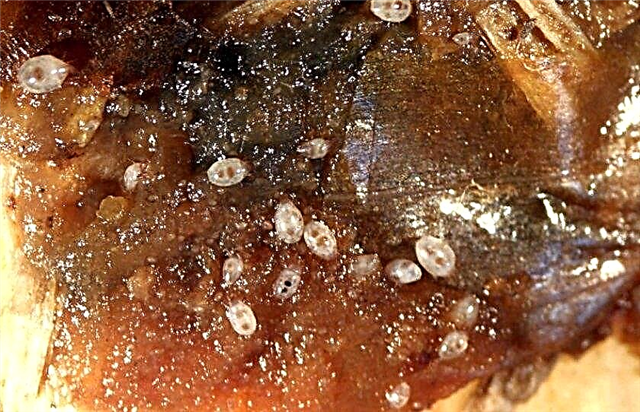 Gladiolus can also be affected by an onion mite. It infects the tubers of a flower and penetrates them through damaged areas. This pest lives in the ground. He sucks all the juice from the bulb, as a result of which the plant dries and fades. The tick can hibernate in the bulbs if they are not properly cleaned before storage. The main method of struggle is the use of an uninfected landing site for several years. Infected bulbs are poured with hot water, dried and stored.
Gladiolus can also be affected by an onion mite. It infects the tubers of a flower and penetrates them through damaged areas. This pest lives in the ground. He sucks all the juice from the bulb, as a result of which the plant dries and fades. The tick can hibernate in the bulbs if they are not properly cleaned before storage. The main method of struggle is the use of an uninfected landing site for several years. Infected bulbs are poured with hot water, dried and stored.
Did you know? The name gladiolus was coined by the ancient Roman writer Pliny the Elder, who compared the flower with the ancient Roman sword gladius. Montbrecia got its name thanks to the French botanist de Montbrett.
It is recommended to treat the plant during the growing season with a solution of “Karbofos” or “Celtan”. Now you know why it is worth using Japanese gladioli in the design of garden compositions at your site. They will become an integral part of the flower family, especially if you use a perennial variety. A wide variety of varieties gives you the opportunity to choose a suitable bush for a particular place, so that gladiolus delight with flowering for as long as possible.












